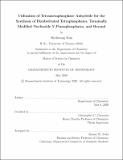| dc.contributor.advisor | Christopher C. Cummins. | en_US |
| dc.contributor.author | Kim, Hyehwang. | en_US |
| dc.contributor.other | Massachusetts Institute of Technology. Department of Chemistry. | en_US |
| dc.date.accessioned | 2020-09-15T21:58:02Z | |
| dc.date.available | 2020-09-15T21:58:02Z | |
| dc.date.copyright | 2020 | en_US |
| dc.date.issued | 2020 | en_US |
| dc.identifier.uri | https://hdl.handle.net/1721.1/127439 | |
| dc.description | Thesis: S.M., Massachusetts Institute of Technology, Department of Chemistry, May, 2020 | en_US |
| dc.description | Cataloged from the official PDF of thesis. | en_US |
| dc.description | Includes bibliographical references (pages 111-114). | en_US |
| dc.description.abstract | In this thesis, the use of tetrametaphosphate anhydride ([PPN]₂[P₄O₁₁]) for the synthesis of substituted tetrametaphosphates, disubstituted tetraphosphates, and [epsilon]-labelled nucleoside 5'-pentaphosphates was explored. Treatment of anion [P4₄O₁₁]²⁻ with phenol derivatives, primary and secondary amines, and phosphorus ylides under anhydrous conditions results in the corresponding substituted tetrametaphosphates. Further treatment of the resulting tetrametaphosphates with a second nucleophile such as hydroxide, amines, and nucleoside monophosphates results in ring opening to a linear tetraphosphate derivative bearing the two nucleophiles on each terminal end. This method was used for the synthesis of [epsilon]-fluorophore labelled nucleoside 5'-pentaphosphates, an important class of reagents for high-throughput DNA sequencing. The reaction between anion [P₄O₁₁]²⁻ and methylidene triphenylphosphorane yields a new tetrametaphosphate based ylide, which was shown to undergo the Wittig reaction with suitable aldehydes. One interesting example of such a Wittig reaction was between 2',3'-O-isopropylidene-5'-uridylaldehyde and the tetrametaphosphate ylide which led to a 3'-deoxy-3',4'-didehydronucleoside derivative. For the penta- and hexaphosphorylation of nucleosides, two new bicyclic phosphate anhydride compounds, [PPN]₃[P₅O₁₄] and [PPN]₄[P₆O₁₇], were synthesized. Although conditions for ring-opening anion [P₆O₁₇]²⁻ could not be found, it was found that anion [P₅O₁₄]³⁻ undergoes ring-opening with 4-methylumbelliferone in the presence of ZnCl₂ as a Lewis acid additive. The fluorophore-substituted pentametaphosphate intermediate was found to undergo further ring-opening with primary amines and nucleoside monophosphates to result in disubstituted pentaphosphates and [zeta]-fluorophore labelled nucleoside hexaphosphates, respectively. | en_US |
| dc.description.statementofresponsibility | by Hyehwang Kim. | en_US |
| dc.format.extent | 114 pages | en_US |
| dc.language.iso | eng | en_US |
| dc.publisher | Massachusetts Institute of Technology | en_US |
| dc.rights | MIT theses may be protected by copyright. Please reuse MIT thesis content according to the MIT Libraries Permissions Policy, which is available through the URL provided. | en_US |
| dc.rights.uri | http://dspace.mit.edu/handle/1721.1/7582 | en_US |
| dc.subject | Chemistry. | en_US |
| dc.title | Utilization of tetrametaphosphate anhydride for the synthesis of disubstituted tetraphosphates, terminally modified nucleoside 5'-pentaphosphates, and beyond | en_US |
| dc.type | Thesis | en_US |
| dc.description.degree | S.M. | en_US |
| dc.contributor.department | Massachusetts Institute of Technology. Department of Chemistry | en_US |
| dc.identifier.oclc | 1192966259 | en_US |
| dc.description.collection | S.M. Massachusetts Institute of Technology, Department of Chemistry | en_US |
| dspace.imported | 2020-09-15T21:58:02Z | en_US |
| mit.thesis.degree | Master | en_US |
| mit.thesis.department | Chem | en_US |
